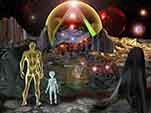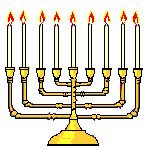(Note - It is very important to remember how the Soviets succeeded for over 40 years in attributing the WWII Katyn Forest mass slaughter of Polish Army officers to the Germans. In fact, the Russians carried out that slaughter. The following stories reveal yet another crucial and important correction of an alleged WWII 'Nazi' atrocity. Bringing history into accord with the facts should be everybody's business. - ed.)
Long after he'd settled comfortably into Melbourne's suburbs, Janek Bienstein remembered his neighbors in his home town of Jedwabne, north-east of Warsaw, in Poland.
He remembered, for instance, who among them had pushed him, his family and almost all of the town's other Jews - some 1600 in all - into a huge barn one evening before dousing it with petrol and setting it on fire.
He remembered whose barn it was, who stood by watching, and who sang joyfully as the Jews packed inside burned to death.
As one of the town's horse-and-cart men, he knew them all - their names, their occupations, their attitudes towards Jews. And he would never forget their roles in the events of July 10, 1941, a fortnight after the Germans displaced the Soviets who had been there since 1939. It was the worst single pogrom to take place in Poland during the war years.
Bienstein named those he held responsible in a section he contributed to Jedwabne History and Memorial (Yizkor) Book in 1980. "No German took part in the actual murder day - the opposite," he wrote.
"Two officers came to the death barn asking the murderers to let live the following professionals: shoemakers, tailors, carpenters and blacksmiths. But the Gentiles answered: 'We won't allow a remnant of the Jews to be left alive. Professionals we'll supply from the Christians'."
It's a view of events that the Poles have until now done their best to deny. A memorial on the site of the massacre lays the blame firmly at the feet of the Gestapo.
But Bienstein's story is just one among many in a book released this past week in Poland, and excerpted as the cover story of the March 12 edition of The New Yorker, and the world is taking note.
The book, Sasiedzi (Neighbors), by American academic and Polish Jew Jan T. Gross, is not due to be published in English until next month. But it has already raised a commotion because, using documented evidence, it lays almost all the blame for the massacre upon the Polish villagers and peasants rather than the German forces.
The Jedwabne pogrom began in the morning as the Poles, of whom 92 are named in written accounts, sought out and killed small groups of Jews hiding in buildings, in fields and in the streets. Some of the Jews committed suicide rather than face their attackers.
One young woman was decapitated and her head kicked around like a football. A three-year-old girl was pitchforked into a fire. A pregnant woman, almost at full term, was disembowelled. One man had a cross cut into his chest.
Through a long hot day, the Jews were rounded up by Poles using clubs and whips on the orders of the mayor. They were herded into the town square where, according to some reports, 75 people were made to carry a heavy statue of Lenin before being executed.
The Jews' religious leader, 90-year-old rabbi Avigdor Bialystocky, was forced to march at the head of the crowd carrying a red flag. The Jews were forced to chant "the war is because of us, the war is for us".
But as the Jews in the barn were saying their last prayers before dying, Janek Bienstein (then known as Neumark) seized his chance.
Immensely strong from his life's work with horses and carts, he had been one of the last forced into the barn, which left him near the door.
As his widow Dora tells it, Janek's father, Reb Shimeon, implored his son to save himself, even as his face was on fire and his eye melting.
"Outside the door stood a man with an axe," says Dora. "He knew him. It was a Pole. As a young boy, they were playing and fighting. And when he sneezed, he recognised the sneeze from inside, and pushed the door himself.
He said: 'You so and so, you want to burn me alive?' And the Pole said: 'Here, Janek, here is the axe. Save yourself. I don't see anything.' And he turned away.
"Janek grabbed his sister and her little girl, and they ran across the road to the cemetery."
It was the beginning of a flight that ended with Janek spending three years as prisoner number 86879 in Nazi concentration camps Auschwitz and Dachau.
At those times when death seemed the easiest option it was, as he wrote later, the thought of being "able to tell what has happened, and what our Polish neighbors did to us" that kept him alive.
When the war ended, he married Dora, originally from Budapest, whom he met in Dachau. She suggested they should each pay one last visit to their home towns before getting on with their new life.
"No, I wouldn't last a day there," he told her. "They would kill me straight away. I was a witness. I was there. I was in it and I was burning."
Fewer than a dozen Jews survived Jedwabne that day, including seven who were hidden together in bunkers under a barn by a brave Polish woman. One of them, the late Szmul Wasersztejn, went on to record a deposition in 1945 that ultimately led Jan Gross to the truth.
In Jedwabne, the massacre had been commemorated by a rough stone in a field with an inscription that reads: "Scene of a massacre of the Jewish population. The Gestapo and German police burned 1600 people alive."
It was a lie, symptomatic of a long cover-up that is only now being exposed and examined in a burgeoning debate opened up by Professor Gross.
He says his evidence challenges the Poles' notion of themselves solely as victims during the war. Some three million Jews were killed, and a similar number of non- Jews, in Poland.
Last Thursday, authorities in the town removed the disputed monument in the first concrete response to his contention that it was the Polish townspeople and outlying villagers, rather than the occupying German forces, who did the killing.
A government body intends to reorganise the site in time for the 60th anniversary commemoration of the massacre this year, and a new investigation has begun into the evidence.
Although some details of the massacre provided by Janek Bienstein in 1980 figure in Sasiedzi, much of the book's information is drawn from court documents relating to the little-known trials of 22 Poles in May, 1949, for their participation in the massacre. Twelve of the 22 were convicted and sentenced to jail terms. One death sentence was commuted.
Professor Gross says that although the information was available before now, no one had pulled it together and made it part of "what we know" about the Holocaust, which is why it is having such an impact. Most mass killings of Jews have until now been attributed to the Nazis' police battalions and killing squads.
Poland's highest authorities - including the President, Aleksander Kwasniewski, the Polish Catholic primate Cardinal Glemp, and the Prime Minister, Jerzy Buzek - have accepted the essential veracity of Professor Gross' work and have urged Poles to come to terms with the truth.
"The participation of Poles in the Jedwabne crime is undeniable - no serious historian can deny it," Mr Buzek said.
"If we have the right to be proud that some Poles saved Jews from the threat of losing their lives, we must also recognise the culpability of those who participated in their murder."
But this has not convinced some Polish academics and their followers, including the editor of Melbourne's Polish Weekly, Zdzislaw Derwinski. Such critics remain sceptical, charging Professor Gross with making his findings on insufficient evidence and the authorities with being at least premature in accepting them.
Polish Weekly, which serves Melbourne's 22,000 Poles, has published four articles on the issue, each of them tending to undermine or cast doubt on the Gross position.
Speaking from Paris to The Sunday Age, Professor Gross said some of the arguments put forward by Professor Tomasz Strzembosz in the most significant of the articles, tried to paint Jews as having been collaborators with the Soviets, which provided a cover for others' long-standing anti-Semitic prejudices. There was absolutely no evidence of Jews' collaboration, he said.
Perhaps ironically, sections of Melbourne's Jewish community have attempted to "soft-pedal" relations with local Poles, trying to reassure them they are not "anti- Polonists" by focusing attention on Poles who helped Jews during the war.
Michael Nadworny, an influential Polish Jew, says the Anti-Defamation League, the Holocaust Centre and the Federation of Polish Jews have decided to step up efforts to tour the exhibition Courage to Care, which is currently in Perth. Depicting the stories of so- called "righteous Gentiles", it will travel to Moe in May.
After the war, Janek Bienstein became just another Jewish gent in Melbourne's suburbs, living first in Moonee Ponds then in Caulfield. He was a worker at Smorgons and GMH, a father of two and a grandfather, too.
Among his circle of friends, though, he was always highly regarded for his heroic deeds in the concentration camps and even earlier. As a boy of 14, he saved 60 people in Jedwabne from another pogrom in 1920 by riding to seek help from a sympathetic Catholic archbishop.
Janek Bienstein died in August, 1997, aged 91. His widow, Dora, 77, who lives in South Caulfield, trembles with inner satisfaction that his quest for justice has been realised. "I just wish it would have come out five years before," she says, "when he was alive." _____
Holocaust Marker Removed - Massacre Culprits Were The Poles
http://archives.seattletimes.nwsource.com By Andrzej Stylinski The Associated Press 3-17-1
WARSAW, Poland - Polish authorities yesterday removed a Holocaust monument that for decades falsely blamed the Nazis for a 1941 massacre of Jews that was actually carried out by Polish villagers.
The small, weathered stone memorial in the town of Jedwabne is to be replaced with a new monument by July 10, the 60th anniversary of the massacre.
New evidence that Polish neighbors herded the community's 1,600 Jews into a barn and set it on fire has torn into Poles' longheld self-image as victims of Nazi occupation - and never as collaborators in Hitler's plan to annihilate European Jewry.
Poland lost 6.5 million citizens, including 3 million Jews, under Nazi occupation. Poles have prided themselves on a resistance movement that took great risks to shelter many Jews and get word of the Holocaust to the outside world.
A book by Jan Tomasz Gross, a Polish ÈmigrÈ who teaches at New York University, uncovered facts that were kept secret or ignored during 40 years of communist rule. Published last year in Polish, an English version of "Neighbors" is due out next month in the U.S.
Gross writes that when Nazi commanders moved into the eastern Polish village, they "easily reached agreement" with town officials on what to do about the Jews. Hundreds, including women and children, were brought to the square. They were beaten with clubs and stones before being locked inside the barn.
A communist-era court convicted 12 villagers in 1949 of collaborating with the Nazis and sentenced them to terms ranging from eight to 15 years. One death sentence was later commuted.
Poland's National Remembrance Institute has launched an inquiry that could lead to a trial of any participants still alive.
http://archives.seattletimes.nwsource.com/cgi-bin/texis/web/vortex/display?slug= massacre16&date=20010316
Courtesy Rense.com






































